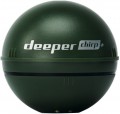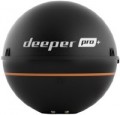Scan depth
the
maximum depth at which the sonar locator (see "Type") is able to operate effectively — in other words, how deep underwater the device is able to "see".
It is worth choosing an echo sounder according to this parameter, taking into account the actual depths at which it is planned to be used. Of course, this does not place a certain margin, but within reasonable limits (15-20%, less). For example, it hardly makes sense to specially take a model with a scanning depth of 200 m for a lake with pits of 30-40 m — such devices are expensive, while there will simply be nowhere to realize their full potential, and a powerful signal can also scare away the fish. But for marine or oceanic applications, a depth of a kilometer or more may be required; the most advanced echo sounders are quite capable of providing it.
Number of beams of radiation
The number of individual beams of radiation emitted by the device with the echo sounder function (see "Type"). The general principle is as follows: the more rays, the more advanced the device is considered and the more additional features it provides. Specific features may be:
— 1. Single-
beam echo sounders are the simplest variety; accordingly, one of their key advantages is low cost. On the other hand, the shortcomings of any beam — both narrow and wide — are fully realized in them (for more details, see "Total angle of radiation"), and there is no question of a detailed determination of the position of individual detected objects (for example, fish).
— 2. In models with
two beams, these beams most often have a common axis, but differ in coverage angle: one is made narrow, directly for measuring depths, the other is wider, for searching for fish and other individual objects. Thus, this option combines the advantages of beams of large and small widths. However such an echo sounder is not capable of fixing the location of the fish relative to the boat.
— 3. Three-
beam echo sounders have all the capabilities of the two-beam echo sounders described above, and in addition, they are also able to determine the location of a fish or other object relative to the boat (right or left).
Number of frequencies
The number of individual radiation frequencies that can be operated by a device with echo sounding function (see "Type").
The features of the frequencies themselves are described in detail below, but here we note that different models may provide different options for distributing frequencies over individual beams (see "Number of radiation beams"). So, in some devices, each beam has its own frequency, in others, individual emitters can be switched, choosing the best option depending on the characteristics of the situation. In general, more frequencies indicate greater versatility, but it significantly affects the price.
Radiation frequency
The frequency(s) of radiation at which the device with the echo sounder function is capable of operating (see "Type").
The higher the frequency, the better the resolution and noise immunity of the device, the better it is suitable for working at high speeds, but the range and coverage suffer. Low-frequency (up to 200 kHz) sensors, on the contrary, "reach" deep and cover a wide angle, but are sensitive to interference and do not work well with fine terrain details and small objects. Accordingly, the first option is considered optimal for shallow depths and high-precision topographic measurements, while the second option is for deep water bodies, as well as for searching for fish and other tasks that require wide coverage.
Models with several radiation beams (see “Number of radiation beams”) often provide different frequencies for individual beams, which allows you to combine the advantages of different options in one device and compensate for their disadvantages.
CHIRP Technology
Sonar support
for CHIRP technology.
The meaning of this technology is to use the echo sounder at the same time several frequencies. In other words, each pulse consists of several signals, each at its own frequency. According to the creators, this allows you to improve image quality, increase detail (including at great depth and high speed) and at the same time reduce the level of noise and other interference on the screen compared to single-frequency sonars. However, models with CHIRP are noticeably more expensive.
Bottom scan
Echosounder support for special
bottom scanning technologies.
"Viewing" the space under the bottom of the boat is a classic sonar mode and is supported by all models by definition. However, in normal mode, the sound beam propagates in the form of a cone, and the area of the bottom that falls under the beam has the shape of a circle. This degrades the accuracy and does not allow you to achieve a detailed image. Thus, many echo sounder manufacturers have developed special technologies to improve the performance of the instrument; Lowrance has DSI, Hummingbird has DI, Garmin has DownVü. The nuances of these technologies may differ, but the basic principle of operation is the same: the echo sounder beam narrows and goes not in a cone, but in a strip. Due to this, the resolution of the device is significantly increased; at shallow depths, such an echo sounder can “draw” even individual stalks of algae, making it possible to distinguish underwater thickets from schools of fish. Some models combine a narrow beam with a classic cone to further expand detection capabilities. However, such devices are expensive.
GPS module
The presence of a native
GPS satellite navigation module in a device with a chartplotter function (see “Type”). This module is responsible for determining the current geographic coordinates of the device and is thus a key element required for effective work with maps. At the same time, there are chartplotters that do not have this function — they are designed to connect an external GPS receiver.
GLONASS support
Possibility of operation of the device with the navigation satellite system GLONASS.
GLONASS (GLOBAL NAVIGATION Sputnik System) is a Russian satellite navigation system positioned as an alternative to GPS. Today it is the second (besides the same GPS) worldwide satellite network. At the same time, in modern electronics, both systems do not compete as much as complement each other: GLONASS support in echo sounders / chartplotters is usually combined with a GPS module (see above). Thanks to this, the device can determine its coordinates from signals from two networks at once, which significantly improves positioning accuracy. In addition, this combination provides an additional guarantee in the event of a failure in the operation of one of the networks.
Ice fishing sensor
The presence
of a sensor for winter fishing in the scope of delivery of the device with the function of an echo sounder (see "Type").
This feature allows the device to be used on ice-covered water bodies. Usually, the sensor itself is made in the form of a float and is designed to be placed directly in the hole. At the same time, some models are also able to “see” directly through the ice to some extent, but this function is usually auxiliary and is intended more for a general assessment of the depth, and not for a detailed display of the situation; and the working depth during such work is less than the regular one. There are two things that are common to all winter sensors: the absence of mounts found in conventional sensors (on the bottom of the boat, transom, etc.), as well as increased resistance to low temperatures.

